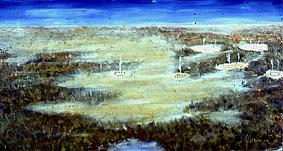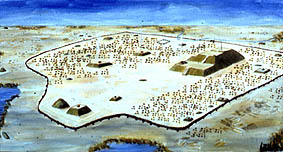
Late Woodland Cahokia site.

Late Mississippian Cahokia site.
| Furthermore, large populations require additional resources. Timber for fires and construction, for example, must be gathered from farther and farther away as successive generations use up nearby resources. Where deer and other game were hunted in large tracts of forests and prairies that once surrounded towns and mound centers were now maize fields. It is likely that a direct consequence of this landscape change and additional hunting was reduction of game populations. In their journey up the Missouri River, for example, Lewis and Clark noted that even their very small party had great difficulty obtaining enough meat as they approached Native American villages (Moulton 1983-1996:4). |

Late Woodland Cahokia site. |

Late Mississippian Cahokia site. |
|
Finally, reliance on maize agriculture in an environment prone to flooding is a recipe for disaster for a large population. Floods would not only ruin crops in the fields and seed in underground storage pits, they would disrupt harvesting of the other dietary staple, fish. Yearly flooding typical of spring and early summer likely had localized impacts that individual households could apsorb through kinship and socio-political mechanisms. Large scale flooding such as that experienced in the valley in 1993 undoubtedly had more serious consequences. |